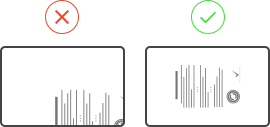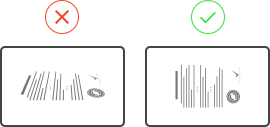الايداع بواسطة حوالة بنكية
من خلال InvestMarkets ، يمكنك تمويل حساب التداول خاصتك عبر حوالة مصرفية مباشرة لحساب التداول الخاص بنا.
متصفح Internet Explorer الخاص بك قديم. للحصول على تجربة مستخدم أفضل، نقترح أن تبدأ في استخدام أحد المتصفحات التالية: Google Chrome أو Firefox Mozilla أو Microsoft Edge.
يتم تشغيل هذا الموقع (www.investmarkets.com/international) من قبل شركة Arvis Capital Limited وهي شركة استثمار بليز، مرخصة و منظمة من قبل لجنة الخدمات المالية الدولية في بليز مع رقم ترخيص 000307/16. تقع Arvis Capital Limited في Unit 203, No. 16 Corner Hutson and Eyre Streets, Blake Building, Belize City, C.A.
وفقاً لاتفاقية وكيل الدفع بين Arvis Capital Limited و Toumpaka Limited، فإن Toumpaka Limited (العنوان المسجل: Efrosini Proestou 16, 2325, Lakatamia, Nicosia, Cyprus. ، قبرص) ، رقم التسجيل HE405187، تقوم بدور وكيل الدفع والذي يقدّم خدمات الدفع ل Arvis Capital Limited.
Arvis Capital Limited و Forex TB Limited تنتميان إلى نفس المجموعة من الشركات. شركة Forex TB Limited منظمة من قبل لجنة الأوراق المالية والبورصات القبرصية برقم ترخيص CIF 272/15.
العقود مقابل الفروقات ( ‘CFD’) هي منتجات مالية معقدة، ذات طابع مضاربة، وينطوي تداولها على مخاطر كبيرة تقود إلى خسارة رأس المال. إن تداول العقود مقابل الفروقات، والتي تعدّ منتج هامشي قد يؤدي إلى خسارة رصيدك بالكامل. تذكر بأن الرافعة المالية في العقود مقابل الفروقات يمكن أن تعمل على حد سواء لصالحك وضدّك. متداولي العقود مقابل الفروقات لا يملكون، أو لديهم أي حقوق، في الأصول الأساسية. بالإضافة إلى أن تداول العقود مقابل الفروقات ليس مناسباً لجميع المستثمرين. لا يشكّل الأداء السابق مؤشراً موثوقاً فيما يتعلق بالنتائج المستقبلية. ولا تشكّل التوقعات المستقبلية مؤشراً موثوقاً فيما يتعلق بالأداء المستقبلي. قبل اتخاذ قرار التداول، ينبغي عليك أن تنظر بعناية إلى أهدافك الإستثمارية، مستوى الخبرة، وتحمّل المخاطر. يجب أن لا تقوم بإيداع أكثر مما أنت على استعداد بأن تخسره. يرجى التأكد من أنك تفهم تماماً المخاطر المرتبطة بالمنتَج والحصول على مشورة مستقلة إذا لزم الأمر. يرجى قراءة وثيقة الإفصاح عن المخاطر.
لا تقدّم Arvis Capital Limited خدمات داخل المنطقة الإقتصادية الأوروبية وكذلك في بعض السلطات القضائية الأخرى مثل الولايات المتحدة الأمريكية، كولومبيا البريطانية، كندا وبعض المناطق الأخرى.
Arvis Capital Limited لا تصدر مشورة، توصيات أو آراء فيما يتعلق بامتلاك، حيازة، أو التخلص من أي منتج مالي. Arvis Capital Limited ليست مستشاراً مالياً.

Record of all transactions.
Amount of money in an account.
A currency is said to appreciate when price rises in response to market demand; It’s stands for an increase in the value of an asset.
Taking advantage of countervailing prices in different markets by making a purchase or sale of an instrument, and simultaneously taking of an equal and opposite position in a related market to profit from the small price differentials.
The price, or rate, that a willing seller is prepared to sell at.
The Australian Dollar.
The departments and processes related to the settlement of financial transactions (i.e. written confirmation and settlement of trades, record keeping).
A record of all economic transactions between the residents of a country with the rest of the world in particular period of time. The balance of payments tracks international transactions, which include merchandise, services, and capital flows.
The value of a country’s exports minus its imports.
A technical analysis tool. The chart represents four significant points: the high and the low prices of a financial instrument, which forms the vertical bar, the opening price, which is marked with a little horizontal line to the left of the bar, and the closing price, which is marked with a little horizontal line of the right of the bar.
The currency in which an investor or issuer maintains its book of accounts; the currency that other currencies are quoted against. In the Forex market, the U.S. Dollar is normally considered the `base` currency for quotes, meaning that quotes are expressed as a unit of $1 USD per the other currency quoted in the pair.
One hundredth of a percent.
An investor who believes that prices and or the market will decline.
A market distinguished by a prolonged period of declining prices accompanied by widespread pessimism.
The price that a buyer is prepared to purchase at; the price offered for a currency.
Bonds are tradable instruments (debt securities) issued by a borrower to raise capital. They pay either fixed or floating interest, known as the coupon. As interest rates fall, bond prices rise and vice versa.
An individual, or firm, that acts as an intermediary, putting together buyers and sellers usually for a fee or commission. In contrast, a ‘dealer’ commits capital and takes one side of a position, hoping to earn a spread (profit) by closing out the position in a subsequent trade with another party.
The Deutsche Bundesbank is the central bank of the Federal Republic of Germany.
An investor who believes that prices and or the market will rise.
A market distinguished by a prolonged period of rising prices (Opposite of bear market).
A chart that indicates the trading range for the day as well as the opening and closing price. If the open price is higher than the close price, then the rectangle between the open and close price is shaded. If the close price is higher than the open price, that area of the chart is not shaded.
A government or quasi-governmental organisation that manages a country’s monetary policy a prints a nation’s currency. For example, the U.S. central bank is the Federal Reserve, others include the ECB, BOE, BOJ.
An individual who analyses charts, graphs and historical data to identify trends and predict future movements. Also referred to as Technical Trader.
The process of settling a trade.
Exposures in foreign currencies that no longer exist. The process to close a position is to sell or buy a certain amount of currency to offset an equal amount of the open position. In other words, it will ‘square’ the position.
A transaction fee charged by a broker.
A document exchanged by counterparts to a transaction that confirms the terms of said transaction.
The standard unit of trading.
The participant, either a bank or customer, with whom the financial transaction is made.
An exchange rate between two currencies. The cross rate is said to be non-standard in the country where the currency pair is quoted. For example: in the USA, a GBP/CHF quote would be considered a cross rate, whereas in the UK or Switzerland it would be one of the primary currency pairs traded.
Any form of money issued by a government or central bank.
The two currencies that make up a foreign exchange rate. For example: EUR/USD, GBP/JPY etc.
The risk of incurring losses resulting from an adverse change in exchange rates.
Opening and closing the same position or positions within the same trading session.
An individual or firm that acts as a principal or counterpart to a transaction. Principals take one side of a position, hoping to earn a spread (profit) by closing out the position in a subsequent trade with another party. In contrast, a broker is an individual or firm that acts as an intermediary, putting together buyers and sellers for a fee or commission.
A negative balance of trade or payments.
A transaction where both sides transfer possession of the currencies traded.
The borrowing and lending of cash. The rate that money is borrowed/lent at is known as the deposit rate (or depo rate). Certificates of Deposit (CDs) are also tradable instruments.
A decline in the value of a currency due to market forces.
A contract that changes in value in relation to the price movements of a related or underlying security, future or another physical instrument. An option is the most common derivative instrument.
The deliberate downward adjustment of a currency’s price, normally by official announcement.
The Central Bank for the European Monetary Union.
Traders account for their positions in two ways: accrual or mark-to-market. An accrual system accounts only for cash flows when they occur, hence, it only shows a profit or loss when realised. The mark-to-market method values the trader`s book at the end of each working day using the closing market rates or revaluation rates. Any profit or loss is booked and the trader will start the next day with a net position.
The currency of the European Monetary Union (EMU) which replaced the European Currency Unit (ECU).
The date on which a trade occurs.
The Central Bank for the United States.
An official exchange rate set by monetary authorities for one or more currencies. In practice, even fixed exchange rates fluctuate between definite upper and lower bands, leading to intervention.
To be neither long nor short is the same as to be flat or square. One would have a flat book if he has no positions or if all the positions cancel each other out.
The Federal Reserve monetary committee.
The simultaneous buying of one currency and selling of another in an over-the-counter market. Most major Forex is quoted against the U.S. Dollar.
The pre-specified exchange rate for a foreign exchange contract settling at some agreed future date, based upon the interest rate differential between the two currencies involved.
The pips added to or subtracted from the current exchange rate to calculate a forward price.
FRA are transactions that allow one to borrow or lend at a stated interest rate over a specific time period in the future.
The front office usually comprises of the trading room, and other main business activities.
Analysis of economic and political information with the objective of determining future movements in a financial market.
An obligation to exchange a good or instrument at a set price on a future date. The primary difference between a “future” and a “forward” is that futures are typically traded over an exchange (Exchange- Traded Contacts – ETC), versus forwards, which are considered Over The Counter (OTC) contracts. An OTC is any contract NOT traded on an exchange.
The five leading industrial countries, including USA, Germany, Japan, France and UK.
The seven leading industrial countries, including USA, Germany, Japan, France, UK, Canada and Italy.
Total value of a country’s output, income or expenditure produced within the country’s physical borders.
A gross domestic product plus income earned from investment or work abroad.
An order left with a dealer to buy or sell at a fixed price. The GTC will remain in place until executed or cancelled.
Making a position or combination of positions to reduce the risk of trader’s primary position.
Usually stands for the highest traded price and the lowest traded price of the underlying instrument during a trading day.
An economic condition where there is an increase in the price of consumer goods, thereby eroding purchasing power.
The initial deposit of collateral required to enter into a position as a guarantee on future performance.
The Foreign Exchange rates at which large international banks quote other large international banks.
Action by a central bank to influence the value of its currency by entering the market. Concerted intervention refers to action by a number of central banks to control exchange rates.
An exchange of two debt obligations when each of them have different payment streams. The transaction usually exchanges two parallel loans; one fixed and the other floating.
The New-Zealand Dollar.
Economic variables that are considered to predict future economic activity (i.e. Unemployment, Consumer Price Index, Producer Price Index, Retail Sales, Personal Income, Prime Rate, Discount Rate, and Federal Funds Rate).
Also called margin. The ratio between the amount used in a transaction to the required security deposit.
The London Inter-Bank Offered Rate. Large international banks use LIBOR when borrowing from another bank.
The closing of an existing position through the execution of an offsetting transaction.
The ability of a market to accept large transaction with minimal to no impact on price stability.
A position to purchase more of an instrument than is sold, hence, an appreciation in value if market prices increase.
A position that appreciates in value if market prices increase. When the base currency in the pair is bought, the position is said to be long.
The Canadian Dollar.
A unit to measure the amount of the deal. The value of the deal always corresponds to an integer number.
The required equity that an investor must deposit to collateralise a position.
A dealer who regularly quotes both bid and ask prices, and is ready to make a two-sided market for any financial instrument.
An order to buy/sell at the best price available when the order reaches the market.
A contingent order where the execution of one part of the order automatically cancels the other part.
An order that will be executed when a market moves to its designated price. Normally associated with GTC Orders.
An active trade with corresponding unrealised profit and loss, which has not been offset by an equal and opposite deal.
An agreement that allows the holder to have the option to buy/sell a specific security at a certain price within a certain time. There are two types of options: call option and put option. A call is the right to buy, while a put is the right to sell.
An order is an instruction, from a client to a broker to trade. An order can be placed at a specific price or at the market price. Also, it can be good until filled or until close of business.
A trade that remains open until the next business day.
The term used in currency market to represent the smallest incremental move an exchange rate can make. Depending on context, normally one basis point (0.0001 in the case of EUR/USD, GBD/USD, USD/CHF and 0.01 in the case of USD/JPY).
A position is a trading view expressed by buying or selling. It can refer to the amount of a currency owed by an investor.
In the currency markets, it is the amount of points added to the spot price to determine a forward or futures price.
The actual “realised” gain or loss resulting from trading activities on closed positions, plus the theoretical “unrealised” gain or loss on open positions that have been Mark-to-Market.
An indicative market price; shows the highest bid and/or lowest ask price available on a security at any given time.
A recovery in price after a period of decline.
The difference between the highest and lowest price of a future recorded during a given trading session.
The price of one currency in terms of another.
This type of trade involves the sale and later re-purchase of an instrument, at a specified time and date. Occurs in the short-term money market.
A term used in technical analysis indicating a specific price level at which a currency will have the inability to cross above. Recurring failure for the price to move above that point produces a pattern that can usually be shaped by a straight line.
To hedge one’s risk they will employ financial analysis and trading techniques.
A process in which the settlement of a deal is rolled forward to another value date. The cost of this process is based on the interest rate differential of the two currencies.
The process by which a trade is entered into the books and records of the counterparts to a transaction. The settlement of currency trades may or may not involve the actual physical exchange of one currency for another.
To go ‘short’ is to sell an instrument without actually owning it, and to hold a short position with expectations that the price will decline so it can be bought back in the future at a profit.
An investment position that benefits from a decline in market price. When the base currency in the pair is sold, the position is said to be short.
A transaction that occurs immediately, but the funds will usually change hands within two business days after deal is struck.
The current market price. Settlement of spot transactions usually occurs within two business days.
The difference between the bid and offer (ask) prices; used to measure market liquidity. Narrower spreads usually signify high liquidity.
An order to buy/sell at an agreed price. One could also have a pre-arranged stop order, whereby an open position is automatically liquidated when a specified price is reached or passed.
A technique used in technical analysis that indicates a specific price ceiling and floor at which a given exchange rate will automatically correct itself.
A currency swap is the simultaneous sale and purchase of the same amount of a given currency at a forward exchange rate.
An effort to forecast prices by analysing market data, i.e. historical price trends, averages, volumes, open interest, etc.
A minimum change in price, up or down.
Simultaneous buying and selling of a currency for delivery the following day.
Both the bid and ask rate is quoted for a Forex transaction.
The interest rate at which U.S. banks will lend to their prime corporate customers.
The date on which counterparts to a financial transaction agree to settle their respective obligations, i.e., exchanging payments. For spot currency transactions, the value date is normally two business days forward. Also known as maturity date.
A statistical measure of a market or a security’s price movements over time. It is calculated by using standard deviation. Associated with high volatility is a high degree of risk.
The number, or value, of securities traded during a specific period.
التداول في الفوركس/العقود مقابل الفروقات يحمل درجة عالية من المخاطرة لرأس مالك بسبب تقلبات السوق الأساسي. هذه المنتجات قد لا تكون مناسبة لجميع المستثمرين. وبالتالي، يجب عليك التأكد من أنك تفهم المخاطر وطلب المشورة من مستشار مالي مستقل ومرخص بشكل مناسب.



نحتاج إلى بضع دقائق للتحقق من المستندات الخاصة بك. يرجى عدم إغلاق هذه النافذة حتى ننتهي. شكراً.




يجد معظم عملائنا سهولة أكثر في تحميل هذه المستندات باستخدام هواتفهم المحمولة.
• الرجاء إدخال رقم هاتفك المحمول والنقر فوق زر "إرسال".
• تم إرسال رسالة نصية إلى هاتفك المحمول.
• الرجاء الضغط على الرابط الذي تلقيته في الرسالة النصية.
• الآن يمكنك البدء في تحميل الوثائق الخاصة بك.

لا تحجب أي جزء من المستند.

لا تحجب أي جزء من المستند.

لا تحجب أي جزء من المستند.

لا تحجب أي جزء من المستند.
من خلال InvestMarkets ، يمكنك تمويل حساب التداول خاصتك عبر حوالة مصرفية مباشرة لحساب التداول الخاص بنا.
في حال تم رفض معاملتك، يمكنك الحصول على مساعدة فورية مندعم العملاء لدينا.
الدردشة الآن





التداول في الفوركس/العقود مقابل الفروقات يحمل درجة عالية من المخاطرة لرأس مالك بسبب تقلبات السوق الأساسي. هذه المنتجات قد لا تكون مناسبة لجميع المستثمرين. وبالتالي، يجب عليك التأكد من أنك تفهم المخاطر وطلب المشورة من مستشار مالي مستقل ومرخص بشكل مناسب.
يُرجى ملاحظة أنه يمكن تحصيل رسوم معاملات بطاقات الائتمان باليورو أو بأي عملة أخرى ، اعتمادًا على مزود خدمة الدفع المتاح الذي ستستخدمه الشركة ، وتحتفظ الشركة بالحق في المضي قدمًا في تحصيل الرسوم منك بأي عملة دون إعلامك و / أو الحصول على موافقتك المسبقة
ستتم عملية الدفع من خلال InvestMarkets/international. ستظهر هذه الرسوم في كشف حسابك على النحو التالي www.investmarkets.com/international. لا تتردد في الاتصال بنا على رقم 1177 753 10 27+. يتم تشغيل هذا الموقع من قبل Arvis Capital Ltd، رقم التسجيل 155.177 (عنوان مسجل: No.5 Cork Street, Belize City, Belize).عنوان المكتب الرئيسي: Unit 203, No.16 Cor. Hutson and Eyre Streets, Blake Building, Belize City, Belize. الشركة منظّمة من قبل لجنة الخدمات المالية الدولية في بليز مع رقم ترخيص 000307/16.
فإن Toumpaka Limited, (عنوان مسجل: Kolonakiou 25, ZAVOS KOLONAKIOU CENTER, BLK B, Flat 102, Linopetra, 4103 Limassol, Cyprus) رقم التسجيل HE405187, تقوم بدور وكيل الدفع والذي يقدّم خدمات الدفع ل Arvis Capital Limited.
ليس لديك حساب؟ قم بالتسجيل
كجميع الفرص الاستثمارية، ينطوي تداول الفوركس والعقود مقابل الفروقات على مخاطر الخسارة. هنا في InvestMarkets، نوفر لك إمكانية الوصول إلى مركز تعليمي، أدوات لإدارة المخاطر وفريق دعم العملاء.
هذا القسم مفتوح للعملاء فقط، يرجى تسجيل الدخول أو الإشتراك